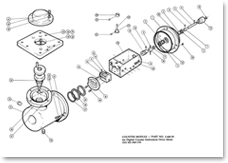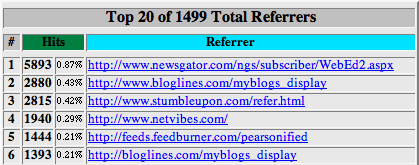When designing or re-designing a Web site, I can’t help but examine the Information Architecture (IA) of the site that’s on the chopping block. Typically, I make a few fundamental changes to the way information is displayed, and one thing I’ve noticed is that I trend towards bringing the newest content to the forefront. I’m sure some of you are reading this and thinking “well, duh,” but I’m actually writing this today to suggest that it may not be quite as duh as you might think…
 Thanks to the widespread growth of RSS as a means of content propagation, blog developers need to start thinking outside the traditional architectural box, which usually consists of uploading a CMS and not giving it much more thought. At this point in time, the widespread solution for blog IA is content-centric; however, as we begin to adapt to changing standards, I believe that we’ll learn to present content in ways that are far more user-centric.
Thanks to the widespread growth of RSS as a means of content propagation, blog developers need to start thinking outside the traditional architectural box, which usually consists of uploading a CMS and not giving it much more thought. At this point in time, the widespread solution for blog IA is content-centric; however, as we begin to adapt to changing standards, I believe that we’ll learn to present content in ways that are far more user-centric.
The default structure and why it blows
Darn near every blog is the same, and this is thanks to the fact that just about every Content Management System (CMS) on the planet has the same default IA structure for blogs. Generally speaking, blogs are presented in reverse chronological order – that is, the newest, freshest content is presented first.
Unfortunately, this setup is speeding towards antiquity. It works for news sites, but unless your site falls under this heading, then I’m going to suggest that this is likely not the best setup for you! With that in mind, what’s the problem here?
The redundancy issue
By default, RSS feeds pick up and spit out content in reverse chronological order. This bit of information is incredibly important for your site, though, because it’s actually the catalyst behind this movement towards widespread IA makeovers.
Everywhere your content is replicated on the web (see Technorati, Bloglines, or any other feed-based aggregator), your “fresh” articles get all the face time. Moreover, if you’re running a blog that’s been around for any length of time, then it’s likely that most of your visitors are coming to you via their preferred feed aggregator. Need proof? Look at my referral stats from June 2006:

The important thing to note here is that my top 6 referral agents were feed aggregators! Additionally, other less popular aggregators also made my top 20 referral list.
So, what does this all mean in terms of the Informational Architecture of your site?
For starters, those who’ve just come to your site via a feed reader have already seen the latest entries that your site has to offer. If you’re the least bit concerned about retaining that person who has just arrived at your site, then, do you really think it’s in your best interest to present them with an identical list of reverse-chronological content once they’ve arrived at your site?
Thanks to RSS, the default method of content presentation on blogs has become, in my opinion, unnecessarily redundant.
I guess my point here is that while it’s not bad to present content in that manner, it’s just not going to gain you anything extra, either. Therefore, instead of letting a retention opportunity go by the wayside, wouldn’t it be smarter to push your very best content to the forefront instead?
Don’t you think your readers (especially new ones!) would be more interested in your best work instead of your most recent work?
Don’t blogs provide a killer feedback system that helps you determine what your best work really is, at least from a global acceptance standpoint?
Don’t you think you could use some of this knowledge to your advantage?
The solution
I’m certainly not coming to you claiming infallibility – even this blog is fundamentally flawed according to what I’ve established above. Here’s what I think should be changed:
- Blast the notion of presenting the freshest content in the most important area of the page
- Instead, place links to what you think is your very best content in areas that have the highest visibility (Where are those areas?)
- Personally, I’m in favor of highlighting your best content in the actual posting area itself, and I think your best work should take precedence over your most recent work. Again, the goal is to eliminate some of that content replication redundancy that is becoming more and more apparent as the use of RSS grows.
- Before showing the newest content to the readers, afford them a chance to browse your site however they’d prefer – via search, via topic, or even by resource. Once you’ve given the user a chance to do something that they couldn’t do via your feed, then you can give them a chance to take a look at your latest work.
For another fresh perspective on this topic, head on over to Problogger to see what Merlin Mann thinks.
Oh, and please keep in mind that if you run a news site, then reverse chronological order is a good thing for your content. However, if you fall into the vast majority who are running a site of a different nature, then maybe it’s time to re-think your strategy!